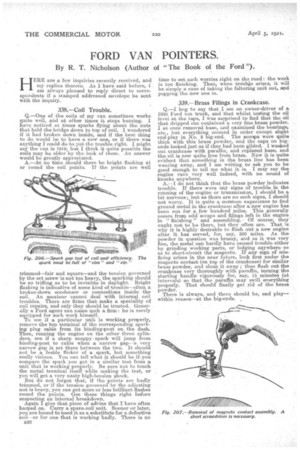FORD VAN POINTERS.
Page 24

If you've noticed an error in this article please click here to report it so we can fix it.
By R. T. Nicholson (Author of "The Book of the Ford ").
HERE are a few inquiries recently received, and my replies thereto. As I have said before, 1 . am always pleased to reply direct to correspondents if a stamped addressed envelope be sent with the inquiry.
338.—Coil Trouble.
Q.—One of the coils of my van sometimes works quite well, and at other times it stops buzzing. I have noticed at times sparks flying about the nuts that hold the bridge down to top of coil. I wondered if it had broken down inside, and if the best thing to do would be to have a new one, or if there was anything I could do to put the trouble right. I might say the van is 1919; but I think it quite possible the coils may be older by the look of them. An answer would be greatly appreciated.
A.—At no time should there be bright. flashing at or round the coil points. If the noints are well trimmed—fair and square—and the tension governed by the set screw is not too heavy, the sparking should be so trifling as to be invisilole in daylight. Bright flashing is indicative of some kind of trouble—often a broken-down condenser or connections inside the coil. An amateur cannot deal with internal coil troubles. There are firms that make a speciality of coil repairs, and only they should be trusted. Generally a Ford agent can name such a firm : he is rarely &pipped for such work himself.
To see if a particular unit is working properly, remove the top terminal of the corresponding sparking plug cable from its binding-post on the dash. Then, running the engine on the other three cylinders,. see if a sharp snappy, spark will jump from binding-post to cable when a, narrow gap—a very narrow gap is set there between the two. It should not be a feeble flicker of a spark, but something really vicious. You can tell what it should be if.you compare the spark you get in a similar test from a unit that is working properly. Be sure not to touch the metal terminal itself while making the test, or you will get a very nasty high-tension shock.
But do not forget that, if the points are badly trimmed, or if the tension governed by the adjusting nut is heavy, you can get more or less brilliant flashes round the points. .Get these things right before suspecting an internal breakdown.
Again I give that piece of advice that I have often harped on. Carry a spare, coil unit. Sooner or later, you are bound to need it as a substitute for a defective coil—or for one that is working badly. There is no B20 be simply a ease of taking the faltering unit out, and is too finicking. Then, when trouble arises, it will time to set such worries right on the, road: the work popping the new one in.
339.—Brass Filings in Crankcase.
Q.—I beg to say that I am an owner-driver of a. 1920 Ford ton truck, and that whilst testing the oil level at the taps, I was surprised to find that the oil that dripped out contained a very fine brass powder. I at once removed base, and examined the bearings, etc., but everything seemed in order except slight end-play in No. 2 big-end. The scoops were quite thick with this brass powder, and the caps on bigends looked just as if they had been gilded. I washed out crankcase with paraffin, and replaced base, and the oil is now quite free from brass. Now it is quite evident that something in the brass line has been wearing away, and I am writing to ask you to be good enough to tell me what it is I may say the engine runs very well indeed, with no sound of knocks anywhere. A.—I do not think that the brans powder indicates trouble. If there were any signs of trouble in the running of the engine or transmission, I should be a bit nervous; but as there are no such signs, I should not worry. It is quite a common experience to find ground metal in the crankcase after a new engine has been run for a few hundred miles. This generally comes from odd scrapsand filings left in the engine in " finishing " and assembling. • Of course, they ought not to be there, but they often are. That is why it is highly desirable to flush out a new engine after it has served, for, say, 500 miles. As the powder in question was brassy, and as it was very fine, the metal can hardly have caused trouble either by grinding working parts, or lodging anywhere-so as to short-circuit the magneto. If any sign of mmfiring arises in. the near future, look first under the magneto contact (on top of the crankcase) for similar brass powder, and clean it away ; then flush out the crankcase very thoroughly with paraffin, turning the starling handle vigorously for, say, 15 minutes (at intervals) so that the paraffin may swill everything properly. That should finally get rid of the brass powder. There is always, and there should be, end play— within reason—at the big-ends. ,
































